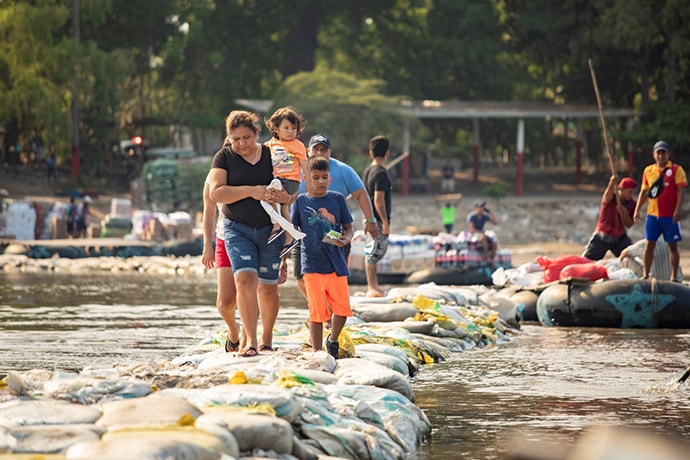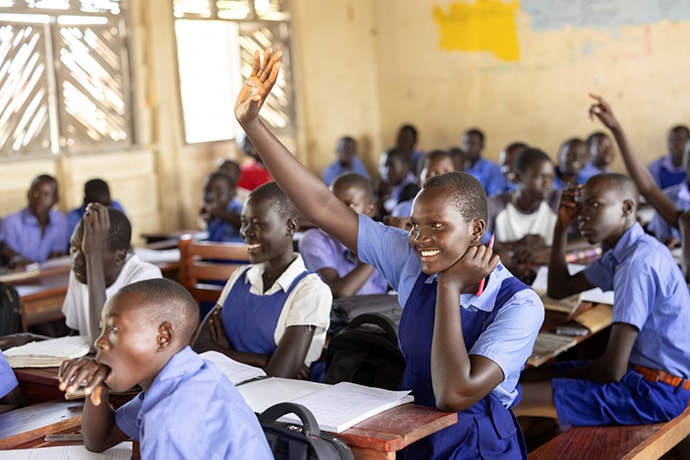By Radwa el Manssy, ChildFund Director for Protecting Children in Crisis

Migrants, refugees, commuters and cargo cross the Suchiate River that forms the border between Guatemala and Mexico. Photo: Jake Lyell for ChildFund
Lately, I have started to collect what I sometimes call “fairy tales” when I visit the areas where my organization, ChildFund, works with children and families who have fled their homes for a better, safer life. One girl I met in Mexico had come all the way from Colombia. I said to her, “Oh, you must be tired!” But she was so optimistic: “We’re very close!” She told me her love story, about a boy that she had left behind.
Of course, too many people also experience horror stories, like Nora and her son who has severe disabilities, fleeing Honduras due to death threats from a gang that had been extorting them. And there is Rose, whose father was killed in a flare-up of violence in South Sudan and whose mother left her alone at 12 in a northern Uganda refugee settlement, with sole responsibility for her two little brothers’ care.
My organization, ChildFund, is a child-focused global nonprofit that works to connect children in vulnerable communities with the people, resources and institutions they need to grow up healthy, educated, skilled and safe. For a child, being forced to leave their home means the loss of their connections with most of what makes it possible for them to survive, let alone thrive.
By the end of 2022, there was a record-setting 43.3 million children on the move, nearly 60% of them fleeing due to conflict and violence. Children also move for many other reasons such as forcible displacement due to climate change, lack of opportunity, trafficking, domestic violence — often a mix. Some become asylum seekers. Some are returning to their home countries. Some have documents, others have none. Some are unaccompanied minors, and others travel with caregivers or relatives. “Children on the Move” is an internationally accepted term that encompasses this array of scenarios affecting children who experience migration, displacement and the effects of either or both.
While their experiences vary, all people who migrate are entitled to their basic human rights — including the right to move, and to do so safely.
The needs of Children on the Move vary depending on a dynamic spectrum of circumstances and factors including their age, gender, ethnicity and other demographic characteristics; the forces driving their migration, any of which have implications for their mental and physical health; local conditions along the road, including legal frameworks and community capacity or inclination to welcome them; who is traveling with them, whether caregiver, relative, friend or no one at all; violence that may erupt due to stress or even criminals they encounter — and much more.
All these factors shape children’s ability to access basic needs on the road, including but not limited to protection, food, money, shelter, health (for example, access to medicine for chronic conditions); mental health issues; water, sanitation and hygiene; language and legal support. Imagine struggling to get what you need while traumatized, or after losing a loved one, far from all that is familiar — including school, which, under these circumstances, may seem a luxury.
ChildFund’s holistic approach with this diverse population aims to address needs related to both immediate and long-term well-being. We do so across a continuum of care for children, youth and families in three categories: those who are (1) at risk of migration, (2) those in transit and needing humanitarian assistance, and (3) those reintegrating in host communities or returning home. Protection is a central element of all our initiatives to support these groups.
The work with the first group is about prevention: We believe that children are more likely to thrive within their own communities, cultures and identities, so we support children and their families not to leave their communities. Much of our ongoing programming work in Guatemala, Honduras and Mexico serves this purpose by helping communities create better opportunities for young people, supporting civic engagement by youth so that they feel included and useful where they are, and, when people make the difficult choice to seek a better life elsewhere, assisting them to make informed decisions toward undertaking the journey safely and legally. We do not facilitate irregular migration, but, again, movement is a human right, and it is critical to ensure that people have the information and tools to migrate safely and through the proper mechanisms.
In Mexico, for example, we help children and youth stay integrated within their communities by helping them build their resilience and better understand their rights as well as working with local organizations to strengthen community-based support mechanisms. We also help young people reaffirm their connection to their own communities and educate them about the risks of irregular migration — that is, illegal means for travel. Efforts to help young people expand livelihood opportunities include leveraging the new technology of the new world that the COVID pandemic has created; young people create commodities that they then sell online. This not only helps them generate income, but it also affirms their aspirations, which is a critical piece of our programming for youth.
For children and families who have left their communities and are in transit, we partner with a broad network of shelters, including shelters supported by governmental and faith-based organizations across Mexico and Honduras, extending our reach to provide safe havens for children and families. Young professionals from local communities provide immediate assistance to families, including health, protection and legal services. (We constantly have to encourage them to exercise self-care and shorten their 12-hour days!)
While programs in both countries offer safe spaces for children and their families to seek information, the balance and nature of services vary according to geography. In Mexico, where many families are waiting to enter the U.S., we offer an extensive health program because families spend a longer time there after having come from as far away as Colombia or Venezuela or beyond. We also do a lot of outreach in Mexican communities to help them expand their capacity to host as many people as decide to stay there; over the long term, our programs support communities to become more welcoming by fighting xenophobia and supporting local governments to expand their services to include children and families on the move. In Honduras, where families typically spend only a week or two, the services tend more toward specific and practical needs for the journey ahead such as shoes, charging stations and the like, as well as spaces where people can find not only safety but also health support, practical information on navigating legal systems, and materials for continuity of basic education for children and youth. We also point them toward safe spaces and shelters they will find on their way north, as well as how to protect themselves as families, especially women and girls, because gender-based violence is very common in this context.
For children and families who have arrived in a destination country and want to settle there, we have large programs in two countries: In Ecuador, we work with people who have arrived from Colombia or Venezuela, and near Uganda’s northern border, we work in the Palorinya Refugee Settlement to support Sudanese and Congolese children and families who have fled conflict in their home countries. Local conditions play an important part in defining the design of programs, but they share core focuses including economic recovery, psychological support, integration into the educational systems, rebuilding of social capital and, always, protection.

Rose, 17, fled to Uganda from war-torn South Sudan when she was 12 years old. As sole caregiver for her two younger brothers since then, she was unable to attend school until recently. She intends to become a nurse. Photo: Jake Lyell for ChildFund
Another common factor between the Ecuadorian and Ugandan contexts was both countries’ openness to refugees crossing their borders to stay. In Ecuador, communities have welcomed children and families who wanted to settle there, perhaps in part because they wanted more workers, but there is a cultural connection with people from Colombia or Venezuela. This is also true in Uganda, where the government has given people small plots of land to settle on. Our programs there include a special emphasis on strengthening community-based child protection mechanisms to respond to various child protection risks. Three Child-Friendly Spaces in Palorinya play a critical role in providing children safe spaces to play and express themselves, easing their psychological well-being and providing learning opportunities.
Remember Rose in Palorinya? At 17, after five years out of school to care for her younger brothers, she has resumed her education. It makes life harder for the family because she is less able to work, but she sees her challenges as temporary, and she aspires to become a nurse. “If I do not study, who is going to help me?” she asks.
Rose is just one example of the remarkable children and youth making their way to a better, safer life. As we talk about what organizations like ours can or should offer children on the move, I feel strongly that it’s also important to talk about how much young people like Rose have to offer the rest of us.
When children and families have lost their homes and build new lives in new places, it’s clear that they have something invaluable to offer their communities. They are resilient and adaptive. They have grit. We could all learn from a young woman like Rose as she courageously takes hold of her own story and makes her — and our — world a better place.